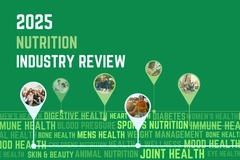
- Industry news
Industry news
- Category news
- Reports
- Key trends
- Multimedia
Multimedia
- Journal
- Events
- Suppliers
Suppliers
- Home
- Industry news
Industry news
- Category news
- Reports
- Key trends
- Multimedia
Multimedia
- Events
- Suppliers
Suppliers
Experts explore natural colors formulation challenge for supplements

US consumers and regulators are increasingly wary of synthetic color additives in food, beverages, and dietary supplements. With the US FDA ban of Red No.3 going into effect in January 2027, nutrition companies are exploring alternatives. However, experts caution that not all natural colors work in all applications or have the same properties as their synthetic counterparts.
Nutrition Insight attended a virtual webinar on navigating the FDA’s revocation of Red No. 3, hosted by ACG, a manufacturer of capsules and pharmaceutical machinery. In the session, regulatory experts from the US and India discussed the ban’s impacts on dietary supplements and pharmaceuticals, examined reformulation strategies, and explored the legal status of natural and synthetic colors.
Vishaka Metkar, regional regulatory director for South Asia at Colorcon Asia, highlighted that regulatory bodies in India for drugs and food don’t have plans to ban the red dye. Colorcon provides pharmaceutical film coating systems, excipients, and packaging solutions for the health and food industries.
“However, for exports, manufacturers must ensure compliance with the destination market’s rules,” she urged.
“Considering the FDA recommendations to remove these synthetic colors and consumer trends toward using natural ingredients, companies should begin exploring reformulation opportunities for foods and dietary supplements.”
At the same time, she cautioned that manufacturers must build a strategy to determine how and when they may reformulate products, as this takes significant time and investments. In addition, she stressed that natural colors require testing for color matching, stability, interactions with other ingredients, and shelf life.
“It’s wise to investigate options now but avoid rushing into full reformulations until the regulatory picture becomes clearer,” Metkar advised.
David Schoneker, president of Black Diamond Regulatory Consulting, echoed Metkar’s call for caution, as regulations are still unclear. He advised companies to consider their options immediately, as growing consumer interest in natural colors will drive demand for these alternatives.
 Experts caution that natural colors often lack the stability, vibrancy, and shelf life of synthetic dyes, making reformulation a slow and costly process.Moreover, he recommended that manufacturers explore their supply chains to ensure access to these materials. “If demand goes up, access may be limited.”
Experts caution that natural colors often lack the stability, vibrancy, and shelf life of synthetic dyes, making reformulation a slow and costly process.Moreover, he recommended that manufacturers explore their supply chains to ensure access to these materials. “If demand goes up, access may be limited.”
“On the pharmaceutical side, there are many challenges to moving into natural colors, and you need to be very cautious about moving too quickly,” Schoneker added. “From a regulatory perspective, there may not be a push on drugs like there is on dietary supplements, because most of your medicines are synthetic anyway.”
Natural coloring challenges
Both experts highlighted several challenges in switching from synthetic to natural colors across dietary supplements and pharmaceuticals, mainly stemming from issues in stability, color shades, and shelf life.
Metkar expanded on one of the most significant formulation challenges — matching synthetic colors with natural alternatives in a way that a target market accepts.
“In many cases, it will not be possible to match the exact shade of a synthetic color as natural colors are often weaker, less vibrant, and unstable,” she detailed. “Even if you find an alternative, its stability would be a major concern, compatibility with other ingredients in the drug formulation could pose a real challenge, and some natural colors will impart a taste depending on the use levels.”
Other issues with natural colors include the stability of the entire formulation and high batch-to-batch variability for natural colors.
Schoneker added: “Many current natural colors have serious stability concerns and don’t have the stability as synthetic colors in light, heat, pH levels, or long-term shelf life, which is why they’re generally approved for many different types of food matrices.”
 Global differences in colorant approvals are creating regulatory hurdles for companies seeking to launch products across multiple markets.He highlighted an example of producing red velvet cupcakes with beet extract instead of Red No. 3 dye. This natural colorant can’t withstand baking heat, turning red velvet cupcakes brown during baking, while Red No. 3 gives it a bright, red color.
Global differences in colorant approvals are creating regulatory hurdles for companies seeking to launch products across multiple markets.He highlighted an example of producing red velvet cupcakes with beet extract instead of Red No. 3 dye. This natural colorant can’t withstand baking heat, turning red velvet cupcakes brown during baking, while Red No. 3 gives it a bright, red color.
Schoneker added that natural colors often struggle with longer-term shelf life. “While a food product often calls for a couple of months of shelf life, because people eat it quickly, that’s not the case for drugs or even dietary supplements in many cases, where we need up to two or three years of stability.”
In addition, he pointed to global natural color supply limitations to replace all synthetic colors by 2026. He believes scaling production in such a short time would not be possible.
“Many of these colors come from food products that we use as food. If everyone starts changing to natural colors, demand will increase, and with limited supplies, we’ll see huge implications in the costs of these colors. That will also affect the costs of food products because there will be shortages.”
Regulatory approval
Differences in approved natural colorants across individual markets make it challenging for companies wanting to reformulate or launch global products.
For example, food and dietary supplement manufacturers in the US can only use colors approved for a specific category or application through the FDA Color Additive Petition process. Schoneker explained that only colors approved for general food use — including most synthetic colors — or authorized for specific use in dietary supplements can be used in that category.
“Many natural colors are only approved for particular food categories, while synthetic colors have broad approvals for general use in food, as they were approved long ago with a lot of safety information. Petitions on natural colors through the years have exposure data limited to specific uses only.”
 Limited global supply of natural color sources could drive up costs and restrict availability if demand increases.He noted there haven’t been any petitions for general food use “for the last 30 years.” He doesn’t expect companies to submit petitions for those broad applications, as this involves significant amounts of toxicology, exposure, and other data on an intended use. In addition, companies going through these processes mainly focus on their target market.
Limited global supply of natural color sources could drive up costs and restrict availability if demand increases.He noted there haven’t been any petitions for general food use “for the last 30 years.” He doesn’t expect companies to submit petitions for those broad applications, as this involves significant amounts of toxicology, exposure, and other data on an intended use. In addition, companies going through these processes mainly focus on their target market.
“One example is riboflavin, which has a yellow color and is approved for use as a color in foods,” Schoneker highlighted. “However, whoever did that petition was mainly interested in riboflavin in foods, so never did the work to justify its use in drugs. Currently, in the US, riboflavin is not approved as a color in drugs because nobody petitioned it for that use.”
“In contrast to natural colors, synthetic colors are approved nearly everywhere in the world, except Libya and Nepal,” added Schoneker. “Natural colors vary by market. Many colors are only approved in certain countries for certain uses; it’s not harmonized.”
Color additive safety
Although a growing segment of consumers believe that natural colors are safer than synthetic versions, Schoneker argued that “this is not true.” Moreover, many natural colors even cause significant allergic reactions.
“Here’s the reality: A chemical is a chemical. Its safety depends on its toxicology, not on whether it’s synthetic or natural. There is no credible evidence that synthetic colors cause cancer or hyperactivity in children.”
He explained that the FDA’s decision to ban Red No. 3 colorant was not driven by safety but by a legal technicality, adding that the FDA’s banning notice explicitly stated there was “no human safety concern” for this color.
“The ban, however, is significant. It will take effect for food and dietary supplements starting January 15, 2027, and for pharmaceuticals starting January 15, 2028, giving the pharmaceutical industry an extra year to reformulate.”
 While consumers view natural colors as safer, experts stress that safety depends on toxicology rather than whether a color is synthetic or natural.The color was banned because the Delaney Clause mandates that the FDA must automatically ban a color additive if “any credible study,” in humans or animals, shows that it causes cancer. Schoneker said this clause was added to the Food, Drug, and Cosmetic Act as a precautionary approach in the 1950s, when toxicology risk assessment tools were limited.
While consumers view natural colors as safer, experts stress that safety depends on toxicology rather than whether a color is synthetic or natural.The color was banned because the Delaney Clause mandates that the FDA must automatically ban a color additive if “any credible study,” in humans or animals, shows that it causes cancer. Schoneker said this clause was added to the Food, Drug, and Cosmetic Act as a precautionary approach in the 1950s, when toxicology risk assessment tools were limited.
He pointed to a study from the 1980s where rats were fed extremely high doses of Red No. 3 — about 4% of their diet. Schoneker, who was involved in the study’s analytical testing, said these levels were “far beyond what humans could ever be exposed to.”
“Only in that highest dose study was there a slight indication of a thyroid tumor. None of the lower, more realistic doses showed any issues. Under the Delaney Clause, however, even that single high-dose finding forced the FDA into a position where they legally had no choice but to ban the dye.”
Moreover, he added: “In this study, the thyroid tumors were caused by a rat-specific hormone that doesn’t exist in humans, which makes the study irrelevant from a human safety standpoint.”
Schoneker pointed out that the FDA hadn’t acted for decades because there was no genuine safety concern. “The turning point came when consumer groups filed petitions, forcing the FDA to make a decision, which triggered the ban.”
Although the FDA has only banned Red No. 3, the organization has requested voluntary removal of synthetic colors by 2026, which Schoneker called “practically impossible for many categories.”











